WHITE GOODS
While household appliances such as refrigerators, washing machines and dishwashers only account for about 30% of total energy consumption in Australia, they account for 53% of residential greenhouse gas emissions (DEWHA 2007).
There has been a substantial growth in ownership of dishwashers by Australian households, with an increase from 25% in 1994 to 45% in 2008. However, the proportion of households using dishwashers on a daily basis decreased substantially, from 37% in 2002 to 29% in 2008 (ABS 2008).
In the period from 1994 to 2008, proportions of households with washing machines, clothes dryers and refrigerators had remained steady, while the proportion of Australian households with separate freezers had decreased slightly. Households were using their washing machine less frequently in 2008 than in 1994 (ABS 2008).
Water efficiency rating, energy star rating and cost were the three main factors considered by households across Australia when replacing or buying major white goods (ABS 2008).
The Victorian government offers a rebate for low income households on white goods which meet a minimum energy efficiency or water saving rating. In 2009, the Victorian government also offered a $100 rebate on energy and water efficient washing machines and dishwashers purchased from 5 June to 28 June.
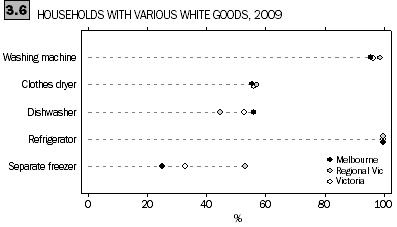
Most Victorian households had a washing machine (2,014,600) and a refrigerator (2,085,500). Just over half of Victorian households had clothes dryers and dishwashers, at 1,168,500 and 1,104,900 households, respectively. Around a quarter (687,000 households) had a separate freezer.
Most households owned a fridge and washing machine regardless of household characteristics as seen in figures 3.7, 3.8, 3.9 and 3.10. However, ownership of clothes dryers, dishwashers and separate freezers differed by tenure type, whether the household had children, size of the household and household income.
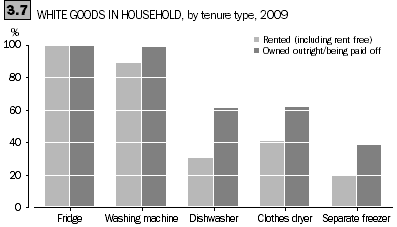
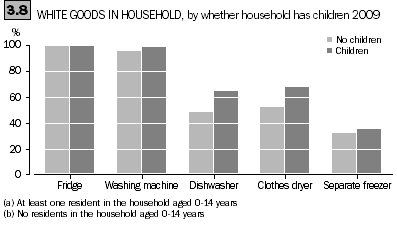
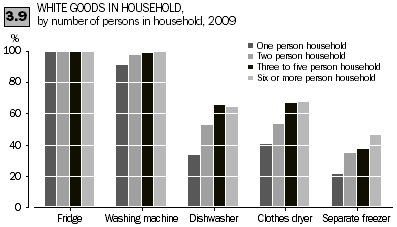
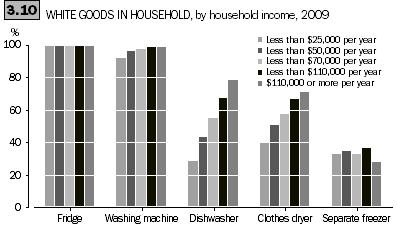
WASHING MACHINES
Melbourne had a higher rate of front loading washing machines (31%) when compared to households in regional Victoria (22%). Overall, households in regional Victoria had a higher rate of top loading washing machines (77%) than Melbourne (65%).
Inner Melbourne SR had the highest rate of households with front loading washing machines at 42%. Inner Melbourne has a high rate of semi-detached dwellings, flats, units and apartments, which also have a higher rate of front loading washing machines (39%) than separate houses (27%).
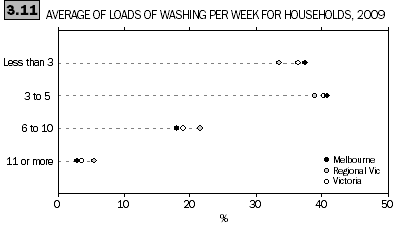
On average, most Victorian households washed five loads or less of washing a week. A small proportion (3.6%) washed 11 or more loads a week. Three-quarters (77%) of persons living alone washed less than three loads of laundry each week. Households with six or more persons and couples with children had relatively high proportions of households that washed 6 to 10 loads a week (55% and 41% respectively). Households with the lowest household income (per annum) were more likely to wash less than 3 loads per week (62%) than households with the highest income (19%).
CLOTHES DRYERS
In Victoria, 1,168,500 households had a clothes dryer. Melbourne and regional Victorian had similar rates of households with a clothes dryer at 55% (833,800 households) and 57% (334,700 households), respectively.
Within Melbourne, the SRs of Mornington Peninsula (covering Frankston down to Sorrento and Portsea) and Outer Eastern Melbourne (including areas such as Ringwood, Healesville and Warburton) had higher rates of households with clothes dryers at 65% and 64%, respectively. North Western Melbourne SR, which covers Brunswick and Coburg out to Sunbury, had a lower rate (44%) of households with clothes dryers.

34% of Victorian households varied their use of the clothes dryer depending on the weather. Households in regional Victoria were more likely to vary using their clothes dryer depending on the weather or season (46%). 31% used their clothes dryer at least once a week while 13% of Victorian households never used their clothes dryer.
Frequency of clothes dryer use varied across household size, whether or not children resided in the household and income. Households with six or more persons or with children had higher rates (43% and 39%, respectively) of clothes dryer use, at least once a week, compared with the 27% of both one person households and households without children. Households in the lowest annual household income range were more than twice as likely to never use their clothes dryer (21%) than those with the highest income (10%).
DISHWASHERS
In Melbourne, 842,500 households had dishwashers while in regional Victoria 262,400 households had dishwashers. A higher rate of households in Melbourne had a dishwasher (56%) than regional households (45%). North Western Melbourne SR had a low rate of households with dishwashers at 39%.
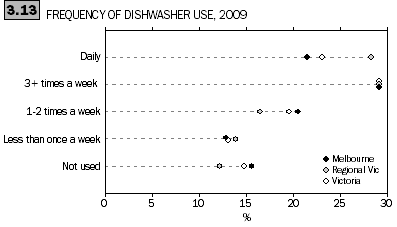
Most Victorian households used their dishwasher between three times a week and daily (52%). For regional Victoria, 28% of households used their dishwasher daily which was slightly more than Melbourne households, at 22%.
How often Victorian households used their dishwasher differed by both family composition and income. A higher rate (41%) of households with children used their dishwasher daily, whereas a relatively low rate (14%) for households without children used their dishwasher daily. For persons living alone, 24% never used their dishwasher, compared to 8.2% of couples with children never used their dishwasher. Households in the highest incomes ranges were more likely to use their dishwasher more frequently, with 33% using the dishwasher daily compared to 8.7% of households with the lowest annual household income.
REFRIGERATORS
Melbourne and regional Victoria had similar rates of households with refrigerators (fridges) equating to 1,501,000 households in Melbourne and 584,500 households in regional Victoria. Inner Melbourne SR had a higher rate of households with one fridge (91%), when compared to Melbourne (76%).
Across Victoria, 74% of households had one fridge and 26% (543,800 households) had two or more. A small percentage had three or more (1.7%). Regional Victoria had a higher rate (32%) of households with two or more fridges than Melbourne (24%).
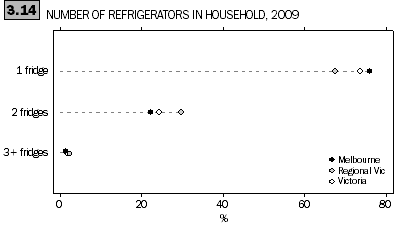
Almost three-quarters of Victorian households had one fridge (74%). Melbourne households were more likely to have one fridge (76%) than regional Victoria (68%). Victorian households with no children (75%) were also more likely to have one fridge than households with children (70%).
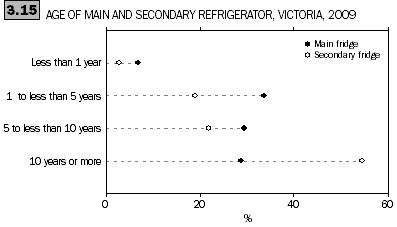
Few Victorian households had a main or secondary fridge less than one year old (6.9% and 2.8% respectively). Of those Victorian households with secondary fridges, most (55%) had secondary fridges that were 10 years old or more.
Households without children were more likely to have a main or secondary fridge 10 years or older, at a rate of 30% for main fridges and 57% for secondary fridges. Households with children had 24% for main fridges 10 years and older and 50% for secondary fridges 10 years and older. Households with the lowest annual household income also had a higher rate of main fridges 10 years or older (37%), than households with the highest annual household income (22%).
Secondary fridges were more likely to be the same age or older than main fridges.
SEPARATE FREEZERS
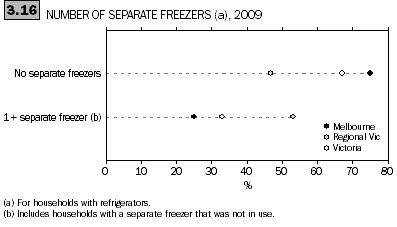
Of Victorian households with fridges, 685,700 had a separate freezer, accounting for 33% of Victorian households. More households (53%) in regional Victoria had a separate freezer than in Melbourne (25%). A lower proportion (6.6%) of households in Inner Melbourne SR had a separate freezer.
Households were more likely to have a separate freezer if there were more people residing in the household or if the dwelling was owned outright. Households with six or more persons had 46% with a separate freezer, whereas households with one person had 21%. 41% of dwellings that were owned outright had a separate freezer, compared to 20% of rented dwellings.
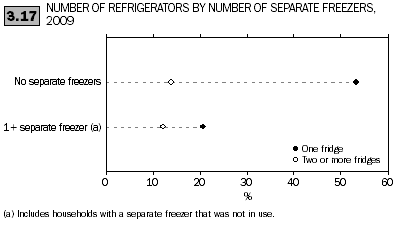
Victorian households were more likely to have a separate freezer if they had one fridge (21%) compared with households with two or more fridges (12%). Households with one fridge were more likely to have a separate freezer if they had a lower income. A quarter of households with incomes of less than $25,000 had one or more separate freezers, but only 15% of households with an income of $110,000 or more had a separate freezer. The proportion of households with two or more fridges and a separate freezer differed by household size. 4.0% of one person households had two or more fridges and a separate freezer, but 20% of six or more person households had the same. Households in regional Victoria also had a greater rate of two or more fridges with a separate freezer at 21%, compared to Melbourne's 8.8%.
References
ABS (Australian Bureau of Statistics) 2008, Environmental Issues: Energy Use and Conservation, Cat. no. 4602.0.55.001, ABS, Canberra.
DEWHA (Australian Government Department of Environment, Water, Heritage and the Arts) 2007, History of the labelling program in Australia <http://www.energyrating.gov.au/history.html> last viewed 5 May 2010.
 Print Page
Print Page
 Print All
Print All
 Print Page
Print Page
 Print All
Print All